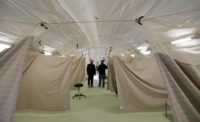
Contractor crews bolted from the starting gate in mid-April, commencing a two-year marathon effort to replace three miles' worth of the Pulaski Skyway northbound deck. About a month after the lanes were completely closed, on April 12, project officials say "Autogeddon" has been avoided so far, thanks to an extensive outreach and traffic-management plan.
New Jersey Dept. of Transportation Commissioner James Simpson detailed, at an April press conference, the decisions that resulted in closing the 81-year-old steel-truss bridge's northern lanes about the $1-billion Pulaski rehabilitation project. Officials from other area transportation agencies, project designers and contractors, and area mayors were present.
While emphasizing that the bridge is not dangerous right now, Simpson invoked the fatal Interstate 35W bridge collapse, in 2007, to explain the need for the closure, saying, "This is not about fixing a pothole. This is about saving lives." Other options would result in six years of construction closures and would have a domino effect on other planned projects that also will affect clogged alternative routes, he noted.
Simpson did not directly mention recent publicity flaps, such as New Jersey Gov. Chris Christie's "Bridgegate" or the criticism over NJ Transit's handling of Super Bowl crowds. But with Jersey City Mayor Steve Fulop at his side, Simpson stated, "Blame us, not the mayor, for any traffic problems. The buck stops with us."
CCA Civil Inc. is in full swing with Contract 3, a $126-million job that entails precasting and placement of 1,145 lightweight concrete panels and 253 exodermic panels with galvanized steel grids, says Greg Borovskis, CCA project manager. Panels are typically 22 ft x 8 ft and weigh about 23,000 lb; precasting is almost complete.
Crews have started demolition of the existing deck, saw-cutting it into panels and lifting them out. Crews installed one million sq ft of temporary shielding for lead abatement before they removed the old steel beams. CCA also won the $210-million Contract 4, which will replace the deck for the southbound lanes.
Long before recent political events, NJDOT wrestled with how to make an inevitably painful project as palatable as possible. Design leader Parsons Brinckerhoff began examining all options in 2005, says Anthony DeJohn, PB deputy Northeast regional business manager.
"We conducted a feasability assessment to determine the best approach—replace, abandon or rehabilitate," says DeJohn. Rights-of-way issues and cost ruled out a new bridge; but with a load of more than 74,000 vehicles daily, the existing span is too vital an artery to abandon.
Interim repairs "bought us five to seven years, but we're now at the five-year mark," DeJohn adds. NJDOT began the implementation of a 10-year plan for major rehabilitation with two contracts: Contract 1, to remove concrete from the eastern spans of the Pulaski to examine the steel beneath; and Contract 2, to make repairs to two adjoining viaducts.
That's when the sense of urgency ramped up, says Richard Hammer, NJDOT assistant commissioner of capital program management. "When we saw the steel, we realized more work would be needed than we thought." Scott Thorn, NJDOT project manager, adds, "We uncovered the steel and took off the casing, and we saw large holes."




Post a comment to this article
Report Abusive Comment